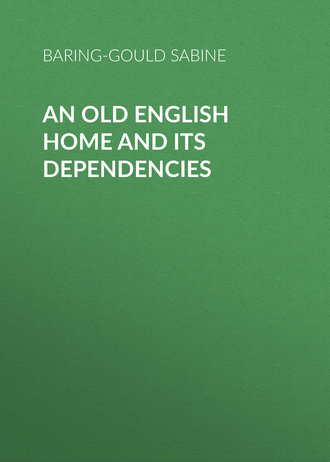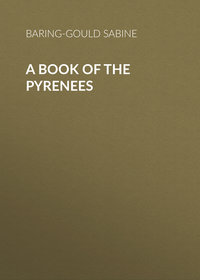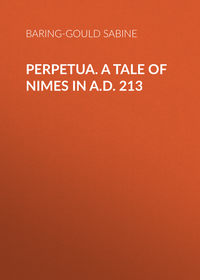 полная версия
полная версияAn Old English Home and Its Dependencies
What our forefathers did was to reduce the top to a thin edge that could not arrest and drive the smoke down, but would, on the contrary, assist it in rising. Or else they covered over the orifice with a roof, open at the sides, that prevented the wind from descending, and enabled the smoke to get away whichever way the wind blew.
In order to illustrate what I mean, I have simply taken my pencil and gone outside my house, and have drawn an old and a new chimney-top.
The chimney-piece or overmantel is the reredos of the family altar, and should contain the arms of the family or the portraits of ancestors.
No portion of an old manor-house was so decorated and enriched as this; and the hall fireplace received pre-eminent attention.
Happily we have in England numerous and splendid examples; but a vast number were sacrificed at the end of last century and the beginning of the present, when large looking-glasses came into fashion, and to make place for them the glorious old sculptured wood was ruthlessly torn down. If the reader is happy enough to possess a copy of Dr. Syntax's Tours, he will see the period of transition. In the second Tour is a plate representing the doctor visiting the Widow Hopefull at York. The room is panelled with oak, the ceiling is of plaster beautifully moulded, the chimney-piece is of oak carved, but painted over, and the large open hearth has been closed in, reduced, and a little grate inserted.
In the same volume is a picture of Dr. Syntax making his will. Here the large open fireplace remains, lined with Dutch tiles, and the fire is on dogs. All the lower portion of the mantel decoration remains, but above the shelf everything has been removed to make way for the mirror.
In the same volume is Dr. Syntax painting a portrait, and here again is a lovely panelled room with plaster ceiling and a simple but charming chimney-piece of excellent design.
Now turn to the first Tour, and look at Dr. Syntax mistaking a gentleman's house for an inn. Here we have the chimney-piece supported on vulgar corbels, all of the period when Rowlandson drew; above the shelf is a painting in the worst description of frame. When Rowlandson made his drawings, he was absolutely incapable of appreciating Gothic design, and whenever he attempted this he failed egregiously, but the feeling for what was later, Elizabethan and Jacobean, was by no means dead in him, and he drew the details with a zest that shows he loved the style.
CHAPTER IV.
Old Furniture
To my taste old furniture in a modern jerry-built villa residence is as out of place as modern gim-crack chairs and tables and cabinets in an ancient mansion. In the first instance you have solidly constructed furniture in a case that is thin, and not calculated to last a century. With regard to the second, happily we have now excellently designed furniture, well constructed on old models; and what I mean by gim-crack stuff is that which was turned out by upholsterers to within the last fifteen years.
Look at the construction of a chair, and see what I mean.
Full well do I recall the introduction into my father's house of these chairs. Only a fragment of one now remains. Observe the legs; they curve out below, and are as uncalculated to resist the pressure downward of a heavy person sitting on them, as could well be contrived. Then again the braces – look at them; they are spindles with the ends let into holes drilled half-way through the legs. Old braces were braces, these are mere sources of weakness, they do not brace; when weight is applied to the seat the tendency is to drive the legs apart, then out falls the brace. No mortice holds it, it has no function to fulfil. In the old chair how firm all the joints are made! Stout oak pegs are driven through every mortice, and every precaution is taken to prevent gaping at the joints, to resist strain put on them.
Mention has been made of the great looking-glass, which was the occasion of the destruction of so many carved chimney-pieces. There was another introduction, and that into the drawing-room, which produced a disfiguring effect, and that was the large circular rosewood table.
At the beginning of this century it entered our parlour, settled there, and made the room look uncomfortable. By no arrangement of the furniture could the drawing-room be given a cosy look. The table got in the way of visitors, it prevented the formation of pleasant groups; it was a very barrier to friendship, and a block to conversation.
One evening, in the South of France, I received intimation from a M. Dols, avocat, that he would be pleased to receive me. I had sent word to him before that I should like to call on him and see some interesting flint swords and celts in his possession. He asked me to call in the evening at 8 p.m. Accordingly I went to his door, and was ushered into the salon. The centre was occupied by a table, of considerable size, and the family was seated beyond the table.
M. Dols occupied B; Mme. Dols occupied C; M. Dols' mother was planted at D; and the maiden sister of Mme. Dols at E. M. Gaston Dols, the son, was at G, and Mlle. Eulalie Dols, the daughter, at F. The chair A was left vacant for the visitor.
But conceive the situation! To be introduced like a criminal before six judges, then, when one had reached the seat allotted, to be planted one in a row, and to have to distribute remarks right and left; to address the ancestress at D across the shirtfront of M. Dols at B, and to say something pretty to the old maid at E athwart the swelling bosom of Mme. Dols at B!
If only that detestable table could have been got rid of, we would have gravitated together into a knot and been happy – but to be lively and chatty in espalier was impossible.
Well! it was almost as bad in the old days, when we had large round tables in our drawing-rooms; and one of the great achievements of modern – I mean quite recent – times has been the bundling of that old rosewood table out. That gone, the rest of the furniture gets together into comfortable groups, and everything finds its place. Before, all were overawed and sent to the wall in deference to the round table.
A word or two is due to the chest of drawers. This, I conceive, is a development of the old oak chest, in which the valuables, or the linen, or the sundry garments of the family were kept. Countless specimens of these oak chests remain; some very fine, some plain. There is, moreover, the spruce chest, made of cypress wood, that was thought to preserve silk and cloth from the moth. Oak chests are usually carved, more or less; cypress chests are sketched over with red-hot iron.
Now there was an inconvenience in the chest. A hasty and untidy person turned its contents upside down to find what he or she particularly wanted, and which was, of course, at the bottom. If the husband did this, he had words cast at him that made him miserable for the rest of the day.
So it was clearly advisable that husband and wife and each child should have a separate chest. But that did not suffice; one was needed for bed linen, one for table linen, a third for personal linen. The result would have been an accumulation of chests, when, happily, the notion struck someone that drawers would solve the difficulty. Let the top of the chest remain immovable, and break up the front into parallel strips, each strip having a drawer behind it.
An old chest of drawers can be known by the way in which the drawers are made to run. They have a groove let into their sides corresponding with a strip of oak or runner on each side of the case; thus they do not rest the one on the other, but on their runners. When each drawer was separately cased in, then the need for runners came to an end.
It is deserving of observation how slowly and cautiously our forefathers multiplied the drawers. At first, two were thought quite as many as could be ventured upon, but after about a century the makers grew bolder and multiplied them.
Does it chance that there be a reader of this chapter who possesses a cupboard, partly open in front, with small balustrades in the door between which the contents of the cupboard can be seen? If he or she has, ten to one but it has been converted into a receptacle for china, or glass, and then china and glass are not only imperfectly exhibited, but become rapidly covered with dust. The possessor of such a little cabinet or cupboard owns something now become very rare, the significance of which is understood by a few only.
Let me describe one in my possession. The height is two feet eight inches, by two feet one inch, and the depth eight and a half inches. There are two doors in front: the upper is perforated and has eight little balustrades in it; the lower door is solid; but this lower door, instead of engrossing the entire front of the cabinet, is small, six inches square, and occupies one compartment of the three, into which the lower portion of the front is divided. Each door gives access to a separate compartment.
Now, what is this droll little article of furniture? What was its original use?
When I answer that it was a livery cupboard, I have little doubt that the majority of my readers will think, as did someone I know who asked about it and received this answer, that it was intended for livery badges – the metal plates with coats of arms engraved on them – worn anciently by servants upon their left arms in a nobleman's and gentleman's household.
But no. A livery cupboard had not this signification. It was the cupboard in which was kept that portion of food and of wine or ale delivered over to each person in the household by the lady of the house for night consumption. Anciently – in the days of Good Queen Bess and of James I. – there was no meal between supper at 7 p.m. and breakfast at 10 a.m., and when each person retired for the night he or she carried off a portion of food, served out, if not by the hands of the hostess, then under her eye; and this "delivery" was carried upstairs to the bedroom and was stowed away in the cupboard appropriated to its use, that on waking in the night, or early in the morning for a hunt or a hawking, or a journey, the food and refreshing draught might be handy, and stay the stomach till all met for the common meal served in the hall at ten o'clock.
We still speak of livery stables, but this does not mean that there coachmen and grooms who wear livery attend to horses, but that the horses themselves receive there their livrée– delivery of so many feeds of oats. This is made clear enough by a passage in Spenser's account of the state of Ireland, written in the middle of the sixteenth century. He says: "What livery is, we by common use in England know well enough, namely, that it is an allowance of horse-meat; as they commonly use the word stabling, as to keep horses at livery; the which word, I guess, is derived of livering or delivering forth their nightly food; so in great houses, the livery is said to be served up for all night – that is, their evening allowance for drink."
Another reference to the custom of serving liveries for all night is made by Cavendish in his Life of Wolsey, where, in giving a description of the Cardinal's Embassy to Charles V. at Bruges, he says: "Also the Emperor's officers every night went through the town, from house to house, where as many Englishmen lay or resorted, and there served their liveries for all night, which was done in this manner: first, the Emperor's officers brought into the house a cake of fine manchet bread, two great silver pots, with wine, and a pound of fine sugar; white lights and yellow; a bowl or goblet of silver to drink in; and every night a staff torch. This was the order of their liveries."
These little livery cupboards usually stood on another, from which they were detached, and which was the "court-cupboard." In this the inmate of the room kept his valuables.
Now let me bid my readers keep a sharp eye on the furniture of cottages when they visit them, for these livery cupboards may still be occasionally found in them, and then they go by the name of "bread and cheese cupboards." I remember many years ago picking up one in a labourer's cottage, that was used for cheese, and it did not lose this smell for a long time afterwards.
But these livery cupboards may also be seen in some churches where doles of bread are given on certain days; and in them, under lock and key, the loaves remain on the day of distribution till given away.
As already intimated, these livery cupboards are now scarce, and it behoves anyone who has one such to treasure it, and anyone who can procure such a cupboard to get it.
There is another cupboard that should be valued – the dear old corner-cupboard. This also has a pedigree.
It was not always put in the corner. Its proper place was in the dining-room, and there it contained the conserves, the distilled waters, the home-made wines that testified to the skill of the housewife. It contained more than that – the nutmegs, the cinnamon, the mace, the pepper, all the precious spices that came from the blessed islands over the sea, and were costly and highly esteemed. In most dining-rooms of the reign of Charles II. or Queen Anne, this cupboard will be found let into the wall, usually arched over above, a necessary adjunct to the room; and when the bowl of punch had to be brewed the lady of the house unlocked it, and at once the whole room was pervaded with fragrance as from the spice isles.
Who among us who are getting old do not recall the peculiar curranty savour of the ancient dining-room? I have a white-haired uncle – he will forgive my telling it – who, when I was a child, and he a young man from Oxford, invariably sought opportunities, and found them, for getting at such a cupboard, and filling his hand first, and then his mouth, with currants. To this day, I never see him without a waft of that old corner-cupboard coming over me.
And the stout and ruddy yeoman, as he dipped the whalebone and silver ladle into the steaming bowl, in which floated circles of lemon, sang:
"Behold the wealthy merchant, that trades on foreign seas,And brings home gold and treasure, for such as live at ease,With spices and with cinnamon, and oranges also,They're brought us from the Indies, by the virtue of the plough."Then came the reign of the Georges, when men built for show rather than for comfort, and the walls were of thin brick overlaid with composition to keep the rain out; and the composition was covered with oil-paint to keep the rain out of the cracks in the plaster and in the bricks. In such houses there were no deep walls in which cupboards could lurk. It was necessary to have cupboards and cabinets made as detached pieces of furniture, taking up room, giving us knocks when we inadvertently run against them; and these cupboards and cabinets were of veneered stuff, common wood underneath, with a thin film of mahogany or rosewood glued on, and every knock given struck off a bit of veneer, and a change of weather scaled off pieces, and gave the whole a shabby, measly look. Then to get her precious cupboard out of the way of being knocked, and thereby her bottles of liqueurs and syrups being knocked over, the lady of the house devised the corner-cupboard.
Also, as things Chinese and Japanese and Indian were much in fashion, these cupboards in the corner were very generally painted dark green or black, and were ornamented with raised gold figures – all in imitation of Oriental flowers and birds and men, and very generally were furnished with beautiful brass-work locks and hinges.
Nearly every old house has its secret cupboard – usually in the wall. Very often one may be found behind the panelling, and near the fire. In my own house is one cut in granite, the stone on all sides, and is the depth of my arm. I have little doubt that these warm, dry cupboards, so secured that no mouse can make its way in, were for the preservation of deeds. Others were for jewellery and plate. The custom of having secret cupboards was continued after cupboards had become independent articles of furniture, standing out in the room; but then they took the form of secret compartments, not opened by keys, but by moving some part of the moulding, or by pressure on some ornamental plate or piece of inlaid wood or ivory.
It is said that everyone has his secret closet, and that in it everyone has his skeleton. I do not know much about the cupboards of nowaday folk, but when I think of those I knew in the olden times, it seems to me that they were full of nothing other than sweets and spices, of gold and gems; anyhow, such were the cupboards of our grandmothers, our maiden aunts, and our great-grandmothers. And when we chance in some secret compartment to light on a bundle of their letters, and look into them, then it is just like the opening of their corner-cupboards, out pours a sweet and spicy fragrance – that of the generous thoughts and kind wishes of their dear old honest and God-fearing hearts.
CHAPTER V.
Ceilings
When I was a small boy at King's College School, I boarded with one of the masters, at a corner house in Queen's Square. There was a long room in which we boarders – there were some five-and-twenty of us – had our meals, and prepared lessons for the morrow in the evening, under the supervision of an usher.
One day at tea, the usher having been summoned out of the room, we boys essayed who could throw up his piece of bread and butter highest. Mine went against the ceiling, and, the butter being unusually thick, adhered.
I was in great alarm; there was no getting it down: it stuck, and neither the usher nor the master, when he entered for prayers, observed it.
During preparation of lessons, during prayers, my eyes reverted to the piece of bread and butter. It remained unnoticed. That it was also unobserved by the servants, who were supposed to clean the room, is not perhaps matter of surprise.
The next day passed – still the bread and butter hung suspended – but on the third day, during prayers, flop! – down it came in front of the master, and left behind it a nasty, greasy stain on the ceiling.
"Whose piece of bread and butter is that?" asked the master, when Amen had been said.
I had to confess, and was whipped.
That stain in the ceiling grew darker daily. The dust of the room adhered to the butter. It was not effaced all the while I remained a boarder, and I involuntarily every day, and frequently daily, looked at it, to see how much deeper the tinge was that the patch acquired.
Years after, when I was a man, and the old master was dead, and the house was in other hands, I ventured to ask the then tenants to be allowed to look at my old school-haunt. And – actually – the bread and butter stain was still there. Like murder – it could not be hid. The ceiling had been repeatedly whitewashed, but ever through the coverings that overlaid it, the butter mark reasserted itself.
I cannot say whether it was this which causes me always, on entering a room, to direct my eyes to the ceiling – but I do, and observe it always with much interest.
The ceiling of the world is not one blank space; it is sprinkled with stars at night, and strewn with clouds by day. Why then should the ceilings of our rooms be blank surfaces? We spread carpets of colour on our floors. We decorate richly our walls. Why should the ceiling alone be left in hideous baldness, in fact, absolutely plain? White ceilings were a product of that worst period of art – save the mark! that age of no art at all, the beginning of the present century.
The ceiling came in in the reign of Henry VIII., and reached its greatest perfection in that of Elizabeth. At a later period the ornamentation became richer, but not so tasteful.
The mouldings were worked with "putty lime," lime finely sifted and mixed with some hair, the lines of the ornamentation were made with ribbons of copper or lead, and the pattern was fashioned by hand over this.
It is supposed that the drops one finds in Tudor ceilings, and which are not of plaster, or plaster only, but of carved wood, are a mere ornament, and purposeless.
This, however, is not the case. Such enriched ceilings are very heavy, and their weight has a tendency to break down the laths to which they adhere, but these pendents are bolted into the rafters, and serve to form so many supports for the entire ceiling, which without them might in time fall.
The Elizabethan ceiling was geometrical in design, but with bands of flower-work, conventional in character, introduced, and sometimes consisted in strap-work, studded with rosettes, wondrously interlacing.
Then came a simpler geometrical pattern, circles enclosing wreaths of flowers copied from nature, exquisitely delicate and beautiful; but the imitation was carried sometimes too far, as when the flower heads are suspended on fine stalks of copper wire.
In a little squirarchical mansion in Cornwall, of no architectural beauty, there was a marvellously beautiful ceiling of the date of Charles II., the flowers and fruit infinitely varied, and wrought with exquisite delicacy. The room was low, and for that reason the artist had taken special pains in the modelling.
A "Brummagem" man bought up the land and the house – this latter was far too small to suit his ideas, and it was left unoccupied.
One day the rector said to him: "I want to have my school treat next Thursday – should rain fall, may I take the children into the old hall?"
"By all means," said the new squire; "but it will be stuffy: I will have it ventilated."
He at once went down with two carpenters and ripped strips through the lovely ceiling from one end of the room to the other, utterly destroying this incomparable work, that must have occupied the artist months of patient labour, and which had called forth the best efforts of his genius.
That is how mulish stupidity is every day destroying the achievements of genius. It is on a level with that of the chawbacon who, having got hold of a Stradella violin, broke it up to light his fire with the splinters.
There was, perhaps, a little heaviness in these ceilings – a little more than there ought to be, and the perfection of plaster work was attained in Germany at a somewhat later period, when the rococo ceilings came in. These were superb – not heavy, but rich with fancy and exquisite in delicacy. This never reached England, or if a foreign workman came here and did a ceiling or two, the art did not take root. Instead it died completely out, and we were left with quite plain ceilings or such as had a centre-piece, cast, of no style – vulgar, tasteless, and mechanical, and of plaster of Paris.
We have come now to recognize, tardily, the right of the ceiling to decoration, and are either papering it or covering it with lincrusta, or papier mâché, or asbestos "salamander" decoration, applied. This is better than nothing, but, of course, is mechanical and monotonous, and can never compete with the work that is the direct outcome of mental effort and manual dexterity.
In connection with a ceiling I subjoin the following story from a friend:
"In 1891 my head mason had an attack of influenza, and this fell on his nerves, and convinced that he had been ill-wished he consulted a white-witch at – , who informed him that he had been 'overlooked' by one of his own profession, and that he had applied too late for a cure to be effected. The man became terribly depressed; he wandered over the country, disappearing for days, and keeping his family in alarm, lest he should make away with himself.
"This went on for several years. He would do no work, he took no interest in anything, and could speak of nothing but his ailments. 'His heart was broke,' such was his description of himself. Well, I was about to rebuild a wing of my mansion, and to make of one large room a ball-room. I went to my bewitched mason and said to him, 'Thomas, I wish you would help me. I am very anxious to have a first-class decorated ceiling to that ball-room, and you know what these Londoners be: they do all by machinery, and you buy a ceiling by the yard – nasty, vulgar stuff I would be ashamed to have seen here. I'll tell you what it is, Thomas, those Londoners come out of town and sail about the country in the holiday time picking up ideas. I think we must show them how a thing in ceilings ought to be done, and let them understand that we are not such fools as they take us to be. Try your hand at my ball-room ceiling. Get it started at any rate.' The man was not a plasterer by profession, but he had done some plaster work for me, and took an interest in it.











